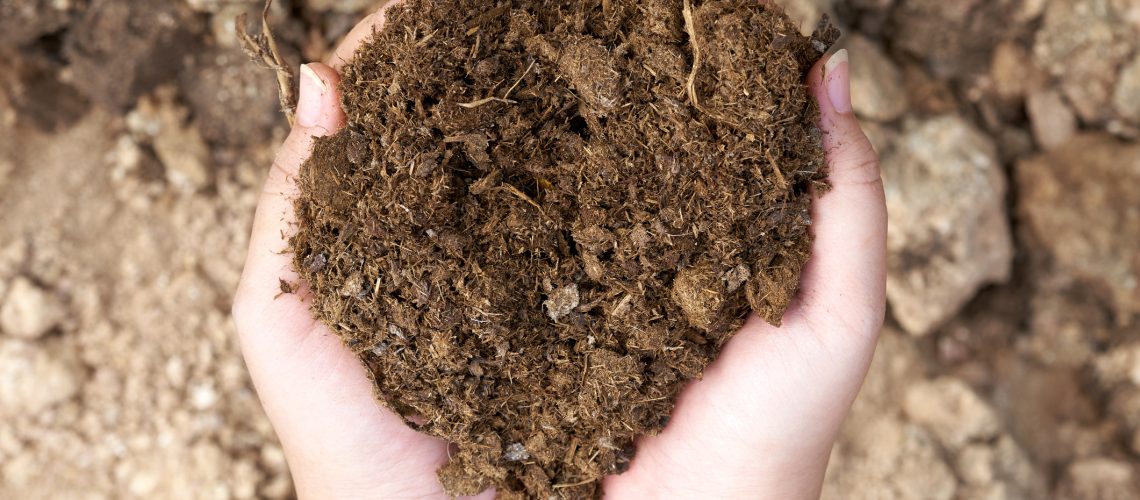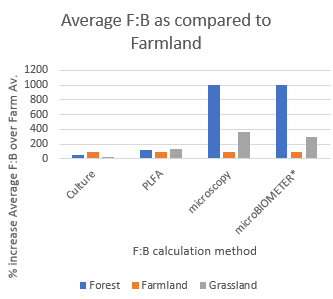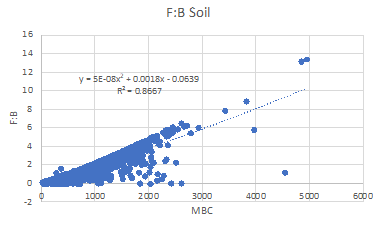-
- microBIOMETER® is the only non-laboratory test for F:B.
- The methods of measuring F:B ratio give very different values 1-11. The Gold Standard for estimating fungal biomass is microscopy, which calculates fungal biovolume. Note that microBIOMETER® detects the same range as microscopy- not surprising as it was validated by correlation with microscopy. For review of these measures see Appendix 1. For measuring progress, stick with one method.
Different methods measure different fungal and bacterial populations. The chart below, adapted from Wang et al review of 192 different F:B ratios, illustrates how three different methods came up with three different F:B ratios for Forest, Farmland and Grassland. Note that microBIOMETER® correlates well with the gold standard, microscopy. By plate culture, forest F:B is about 1/3 that of farmland, whereas PLFA forest F:B is slightly higher, and microscopy and microBIOMETER® forest F:B are 10 times higher than farmland.
- In addition, F:B ratios are strongly affected by the following variables:
- Crop type – forest is typically higher than agricultural,
- AMF – soil of crops that are colonized by AMF have higher F:B
- pH – fungi tend to increase at lower pH
- Sampling site – the rhizosphere of AMF colonized plants has higher F:B
- fertilizer and litter composition – high nitrogen lowers F:B, organic fertilizer regimens increase F:B as well as MBC.
- microBIOMETER® cloud data demonstrates an F:B range of 0-13.5. Note that as the literature predicts, generally the F:B correlates well with MBC. The cloud data portrayed is not identified by user and so we do not have information on the type of soil or crop. From conversations with users, we believe that about 2000 ug MBC/gm soil is the highest seen in agricultural soil, while engineered soils can read higher.
References
- Anderson, J.P. and Domsch, K.H., 1978. A physiological method for the quantitative measurement of microbial biomass in soils. Soil biology and biochemistry, 10(3), pp.215-221.
- Bååth, E. and Anderson, T.H., 2003. Comparison of soil fungal/bacterial ratios in a pH gradient using physiological and PLFA-based techniques. Soil Biology and Biochemistry, 35(7), pp.955-963.
- Bailey, V.L., Smith, J.L. and Bolton Jr, H., 2002. Fungal-to-bacterial ratios in soils investigated for enhanced C sequestration. Soil Biology and Biochemistry, 34(7), pp.997-1007.
- Bardgett, R.D. and McAlister, E., 1999. The measurement of soil fungal: bacterial biomass ratios as an indicator of ecosystem self-regulation in temperate meadow grasslands. Biology and Fertility of Soils, 29(3), pp.282-290.
- De Vries, F.T., Hoffland, E., van Eekeren, N., Brussaard, L. and Bloem, J., 2006. Fungal/bacterial ratios in grasslands with contrasting nitrogen management. Soil Biology and Biochemistry, 38(8), pp.2092-2103.
- Johnson, D.C., 2017. The influence of soil microbial community structure on carbon and nitrogen partitioning in plant/soil ecosystems(No. e2841v1). PeerJ Preprints.
- Khan, K.S., Mack, R., Castillo, X., Kaiser, M. and Joergensen, R.G., 2016. Microbial biomass, fungal and bacterial residues, and their relationships to the soil organic matter C/N/P/S ratios. Geoderma, 271, pp.115-123.
- Malik, A.A., Chowdhury, S., Schlager, V., Oliver, A., Puissant, J., Vazquez, P.G., Jehmlich, N., von Bergen, M., Griffiths, R.I. and Gleixner, G., 2016. Soil fungal: bacterial ratios are linked to altered carbon cycling. Frontiers in Microbiology, 7, p.1247
- Soares, M. and Rousk, J., 2019. Microbial growth and carbon use efficiency in soil: links to fungal-bacterial dominance, SOC-quality and stoichiometry. Soil Biology and Biochemistry, 131, pp.195-205.
- Wallenstein, M.D., McNulty, S., Fernandez, I.J., Boggs, J. and Schlesinger, W.H., 2006. Nitrogen fertilization decreases forest soil fungal and bacterial biomass in three long-term experiments. Forest Ecology and Management, 222(1-3), pp.459-468.
- Wang, X., Zhang, W., Shao, Y., Zhao, J., Zhou, L., Zou, X. and Fu, S., 2019. Fungi to bacteria ratio: Historical misinterpretations and potential implications. Acta Oecologica, 95,


 Different methods measure different fungal and bacterial populations. The chart below, adapted from Wang et al review of 192 different F:B ratios, illustrates how three different methods came up with three different F:B ratios for Forest, Farmland and Grassland. Note that microBIOMETER® correlates well with the gold standard, microscopy. By plate culture, forest F:B is about 1/3 that of farmland, whereas PLFA forest F:B is slightly higher, and microscopy and microBIOMETER® forest F:B are 10 times higher than farmland.
Different methods measure different fungal and bacterial populations. The chart below, adapted from Wang et al review of 192 different F:B ratios, illustrates how three different methods came up with three different F:B ratios for Forest, Farmland and Grassland. Note that microBIOMETER® correlates well with the gold standard, microscopy. By plate culture, forest F:B is about 1/3 that of farmland, whereas PLFA forest F:B is slightly higher, and microscopy and microBIOMETER® forest F:B are 10 times higher than farmland.
